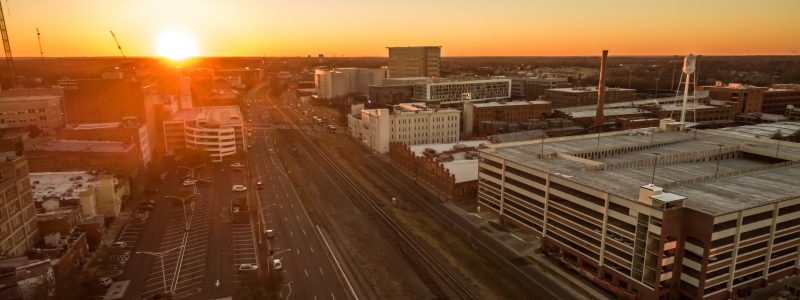
One-hundred and seventy years ago, the North Carolina Railroad was chartered to better connect the eastern portion of the state to the Piedmont. The Railroad offered a mechanism for the more efficient movement of goods and people. The North Carolina Railroad remains a key route for freight and passenger rail service, connecting to two Class I freight rail networks, regional railroads, multiple passenger lines, and the entire east coast rail network.
Today, the Railroad runs through four of the state’s largest cities, thriving downtown areas and rural communities, all of which are experiencing varying degrees of residential and commercial development. What may not be expected, is that the railroad corridor must also grow to accommodate future freight and passenger needs. The question is, how do the two grow together in a way that’s mutually beneficial?
“In many towns, the NCRR corridor consists of one track with approximately 100 feet on each side. When it’s been that way for several decades, towns and cities don’t always consider the possibility that two more tracks could be added that will bump up against a new retail space or condo development,” says Andrew Tate, Vice President of Real Estate. “We have to emphasize long-term planning and relationship building in order for NCRR and the communities to collaborate successfully.”
NCRR’s Real Estate and Corridor Management staff work with the 40 municipalities along the 317-mile railroad to ensure that the corridor factors into cities’ and towns’ long-term plans and development. Preserving the railroad corridor and maintaining the ability to increase capacity by adding future tracks is vital for economic development related to both freight and passenger services.
If city planning impacts the railroad corridor in any way, they collaborate with the Company to find alternative solutions or establish agreements. These agreements outline parameters for accessing the railroad corridor, with the understanding that additional tracks could be located within the corridor at any time, if need arises. Typically, agreements cover beautification efforts maintained by the community, parking lots or temporary structures that can be relocated.
Clayton is one of the fastest growing communities in the Triangle and the town is working to revitalize the downtown area. The NCRR corridor runs through downtown Clayton, and the town is collaborating with the Company to encourage development that accommodates a growing population, while also keeping future rail capacity and safety in mind.
“Agreements are necessary for safety and operational requirements,” says Tate. “Whether it’s an annual parade route through downtown or a master plan to build a mixed-use development adjacent to the railroad corridor, the agreements make it easier for adjacent property owners and communities to understand the guidelines associated with railroad property.”
Tate says that when communities make requests to NCRR that impact the corridor, both parties have to be willing to be creative, with a focus on partnership. “You have to be willing to compromise, while also maintaining standards for safety, operations, and the possibility for future growth.”